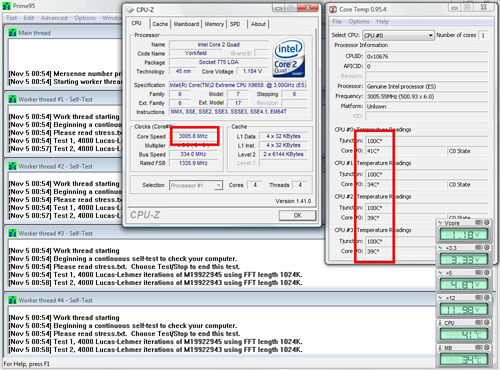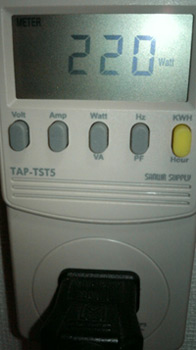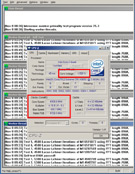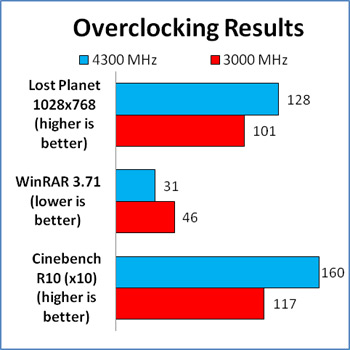|
|
Advertisement:
|
|
Intel Penryn: Fast, cool, and “greenish” |
|
Join the community - in the OCAU Forums!
|
Power and Heat, Overclocking, Final Words
Power Consumption and Heat:
As already mentioned, the QX9650 is specified with a TDP of 130 Watt. This is the same TDP Intel gives for the QX6850. That’s a bit surprising considering all the power and heat reducing technology Intel has implemented. They argue that a “higher performance is achieved at the same TDP”. Nonetheless, we believe that Intel has set the TDP of 130 Watt very conservatively. CPU-Z and Asus Probe showed the QX9650 idling with “Speedstep” enabled at around 1.10 volt. Under full load we observed a voltage reading of between 1.20 and 1.22 volt. The corresponding values for a QX6850 are around 1.20 volt at idle state, and 1.35 volt under load. “Speedstep” kicks in when the system is idling or running with very low load. It drops the multiplier to 6x and by that the processor frequency to 6x333 MHz = 2000 MHz. At the same time core voltage is dynamically lowered down to 1.10 volt.
The wattage monitoring unit we used reads power consumption at the wall plug. The values shown in the “System Power” chart represent therefore total system consumption, including video card, chipset, and peripherals. In idle state the QX9650 system consumed 162 Watt; this is 16% less than the QX6850. The difference is even bigger under full load when Prime95 is running on all 4 cores: The QX9650 system was drawing 220 Watt; the QX6850 was drawing 292 Watt. This is an astounding difference of 25%. In fact the QX9650 was the lowest power consumer among the tested CPUs, even besting the 2 dual core processors.
With an estimated around 700 million PCs in use worldwide the amount of electricity used by desktops and workstations has become an important issue in recent years. Many of these machines sit idle for hours per day, burning electricity, but not doing any work. Microsoft is estimating the world spends US$ 5 to US$ 7 billion dollars every year powering inactive computers and producing 45 million tons of CO2. Cutting down power consumption while the PC is idle is therefore as important as improving overall power efficiency. Conroe/Kentsfield was until now the most power efficient desktop CPU available. But the combination of better clock-by-clock performance with at the same time substantially reduced power consumption makes the Penryn processor family far more power-efficient. The new transistor design with reduced current leakage clearly pays off. We believe that the reduced power consumption is actually Penryn’s most consumer-relevant improvement. It does not only reduce the electricity bill, but also provides for more “silent” computing. Because a Penryn processor dissipates less heat, it needs a less powerful, hence quieter, fan for cooling. The QX9650 we tested was running with the default frequency and default voltage under full load at 41C - that is more than 10C cooler than the QX6850.

CPU temperature at default frequency and voltage
 
Overclocking:
The QX9650, like all “Extreme Edition” processors, has an unlocked multiplier. Intel calls this officially “overspeed protection removed”. The QX9650 can therefore be overclocked by increasing the multiplier. As with previous Intel CPUs, all other non-Extreme 9xxx series processors can only be overclocked by increasing the front-side bus frequency. We tested system stability by running the Prime95 “torture test” for at least 1 hour.
Using Intel’s retail heatsink we managed to run the QX9650 stable with the default core voltage up to 3380 MHz. This was possible without any problem at 10x338 MHz or at 8x422 MHz. We then started increasing the voltage in small steps and ended up at 3000@3600 MHz and 1.25@1.325 volt. At all stages the QX9650 run at least 10C below the temperatures we got with the QX6850. Although we believe that it would be possible to overclock a QX9650 to around 4000 MHz with high-end air-cooling, we changed at this stage to water cooling. After various trials we settled for 10x430 MHz = 4300 MHz. With a processor voltage of 1.52 volt, that is 0.27 volt or around 20% above the specified maximum, the processor could withstand the mandatory 1-hour Prime95 torture test. We then repeated a few of our benchmarks to see how performance is scaling up in line with frequency. It certainly does! We recorded some very impressive performance gains: the multi-CPU score in Cinebench R10 went up 37%, compressing a 90 MB file with WinRAR was 31% faster, and when gaming with “Lost Planet” we enjoyed 28% more frames per second.
 
Cinebench at 4300MHz - Prime95 at 4300MHz

Conroe and Kentsfield processors, in particular the lower clocked versions, are known to offer plenty of overclocking headroom. An average Q6600, for example, can often with simple air-cooling run up to 3000 MHz from the default 2460MHz. It seems though that the cooler running Penryn versions will overclock even better. First reports show QX9650 running with phase-change cooling at 5000 MHz and above. There is also no doubt that Intel could at any time launch a higher clocked Yorkfield version, such as the rumored QX9770, running with a 1600 MHz system bus at 8 x 400 = 3200 MHz.
Final Words:
The QX9650 provides around 5% more frames per second when running games in a resolution of 1024x768. At higher resolutions the difference becomes negligible. Hardcore gamers looking for even the slightest advantage will be nonetheless tempted. Although a 5% gain is nothing to sneeze at, for the occasional gamer it is most probably not significant enough to change from Conroe/Kentsfield to Yorkfield/Wolfsdale.
Penryn truly excels in video encoding: The QX9650 is more than 40% faster, if the new SSE4 instructions can be utilized. But even when encoding only with SSE2, the QX9650 still outruns a QX6850 by 12%. In 3D rendering and image processing the QX9650 is good for a 15% performance boost. For media encoding and desktop publishing a Penryn based processor, in particular one of the quadcore models, is therefore highly recommended.
The same goes for folding: Although we tested only a Gromac work unit, we believe that due to the 50% enlarged L2 cache Penryn CPU will have clock-by-clock a significant higher output than Conroe and Kentsfield. Penryn’s reduced power consumption is another huge plus, because a dedicated Folder keeps his machine(s) usually running 24/7.
Based on our results, we estimate that day-to-day desktop jobs like virus scanning, data compressing, or MS Office jobs are between 3% and 10% faster.
In summary: The new arrival was in each and every test outrunning its predecessor. We cannot stress enough the benefits of Penryn’s reduced power consumption. In the grand scheme of things a 25% lower power consumption matters far more than, let’s say, 10 additional frames per second or 10% shaved off encoding time. The mainstream user will appreciate a lower electricity bill and a quieter system, the “enthusiast” the additional overclocking headroom, and the environment reduced CO2 emissions. And last but not least, it’s good to know that a Penryn processor being lead-free is helping to reduce toxic waste.

The QX9650 has dethroned the QX6850 as the fastest desktop processor. Intel has topped its own performance leader with an even faster processor. Wolfsdale and Yorkfield based CPUs will be positioned in the same price brackets as current 65nm Conroe and Kentsfield parts. The QX9650 is retailing since 12 November 2007. It is listed at various Australian vendors between $1290 and $1390. For sure, the QX9650 and even more the later launched higher clocked QX9770 will not become mainstream products due their high prices. The Q9450, to be launched with the remaining Penryn versions in January 2008, will replace the ever popular Q6660 and hopefully retail at the same price level of around $320. In addition Intel will offer a quadcore model below the Q9450: The Q9300 is running at 2500 MHz and comes with a reduced L2 cache of 2 x 3 MB. It is expected to retail just below the current Q6600 price. Availability right from the beginning should not be a problem as Intel has opened a new facility dedicated to 45nm manufacturing. All said, we have no doubt that the combination of improved clock-for-clock performance with greatly reduced power consumption and heat dissipation will make the Penryn processor family a resounding success.
|
|
Advertisement:
All original content copyright James Rolfe.
All rights reserved. No reproduction allowed without written permission.
Interested in advertising on OCAU? Contact us for info.
|

|


